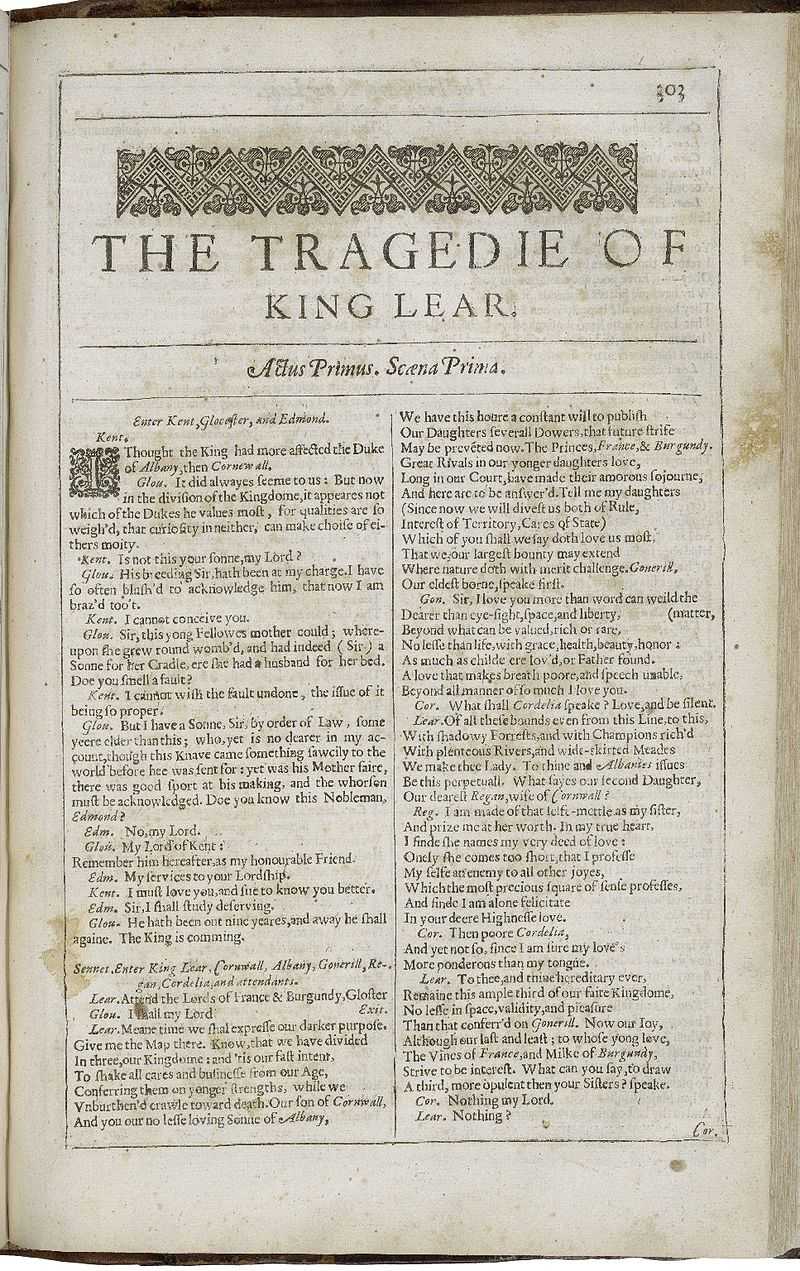King Lear
King Lear is a tragedy written by William Shakespeare. It depicts the gradual descent into madness of the title character after he disposes of his kingdom by giving bequests to two of his three daughters egged on by their continual flattery, bringing tragic consequences for all. Derived from the legend of Leir of Britain, a mythological pre-Roman Celtic king, the play has been widely adapted for the stage and motion pictures, with the title role coveted by many of the world's most accomplished actors.
he first attribution to Shakespeare of this play, originally drafted in 1605 or 1606 at the latest with its first known performance on St. Stephen's Day in 1606, was a 1608 publication in a quarto of uncertain provenance, in which the play is listed as a history; it may be an early draft or simply reflect the first performance text. The Tragedy of King Lear, a more theatrical revision, was included in the 1623 First Folio. Modern editors usually conflate the two, though some insist that each version has its own individual integrity that should be preserved.
After the English Restoration, the play was often revised with a happy, non-tragic ending for audiences who disliked its dark and depressing tone, but since the 19th century Shakespeare's original version has been regarded as one of his supreme achievements. The tragedy is particularly noted for its probing observations on the nature of human suffering and kinship. George Bernard Shaw wrote, "No man will ever write a better tragedy than Lear."

Although an exact date of composition cannot be given, many academic editors of the play date King Lear between 1603 and 1606. The latest it could have been written is 1606, as the Stationers' Register notes a performance on 26 December 1606. The 1603 date originates from words in Edgar's speeches which may derive from Samuel Harsnett's Declaration of Egregious Popish Impostures (1603). In his Arden edition, R. A. Foakes argues for a date of 1605–6, because one of Shakespeare's sources, The True Chronicle History of King Leir, was not published until 1605; close correspondences between that play and Shakespeare's suggest that he may have been working from a text (rather than from recollections of a performance). Conversely, Frank Kermode, in the Riverside Shakespeare, considers the publication of Leir to have been a response to performances of Shakespeare's already-written play; noting a sonnet by William Strachey that may have verbal resemblances with Lear, Kermode concludes that "1604-5 seems the best compromise". Dr. Naseeb Shaheen dates the play c1605-6 per line 1.2.103 "These late eclipses in the sun and moon" which relates to the lunar eclipse of 27 September 1605 and the solar eclipse of 2 October 1605.
The modern text of King Lear derives from three sources: two quartos, published in 1608 (Q1) and 1619 (Q2) respectively, and the version in the First Folio of 1623 (F1). The differences between these versions are significant. Q1 contains 285 lines not in F1; F1 contains around 100 lines not in Q1. Also, at least a thousand individual words are changed between the two texts, each text has a completely different style of punctuation, and about half the verse lines in the F1 are either printed as prose or differently divided in the Q1. The early editors, beginning with Alexander Pope, simply conflated the two texts, creating the modern version that has remained nearly universal for centuries. The conflated version is born from the hypothesis that Shakespeare wrote only one original manuscript, now unfortunately lost, and that the Quarto and Folio versions are distortions of that original. Others, such as Nuttall and Bloom, have identified Shakespeare himself as having been involved in reworking passages in the play to accommodate performances and other textual requirements of the play.
As early as 1931, Madeleine Doran suggested that the two texts had basically different provenances, and that these differences between them were critically interesting. This argument, however, was not widely discussed until the late 1970s, when it was revived, principally by Michael Warren and Gary Taylor. Their thesis, while controversial, has gained significant acceptance. It posits, essentially, that the Quarto derives from something close to Shakespeare's foul papers, and the Folio is drawn in some way from a promptbook, prepared for production by Shakespeare's company or someone else. In short, Q1 is "authorial"; F1 is "theatrical".
The New Cambridge Shakespeare has published separate editions of Q and F; the most recent Pelican Shakespeare edition contains both the 1608 Quarto and the 1623 Folio text as well as a conflated version; the New Arden edition edited by R. A. Foakes is the only recent edition to offer the traditional conflated text. Both Anthony Nuttall of Oxford University and Harold Bloom of Yale University have endorsed the view of Shakespeare having revised the tragedy at least once during his lifetime. As Bloom indicates: "At the close of Shakespeare's revised King Lear, a reluctant Edgar becomes King of Britain, accepting his destiny but in the accents of despair. Nuttall speculates that Edgar, like Shakespeare himself, usurps the power of manipulating the audience by deceiving poor Gloucester."[












0 comments
Sign in or create a free account